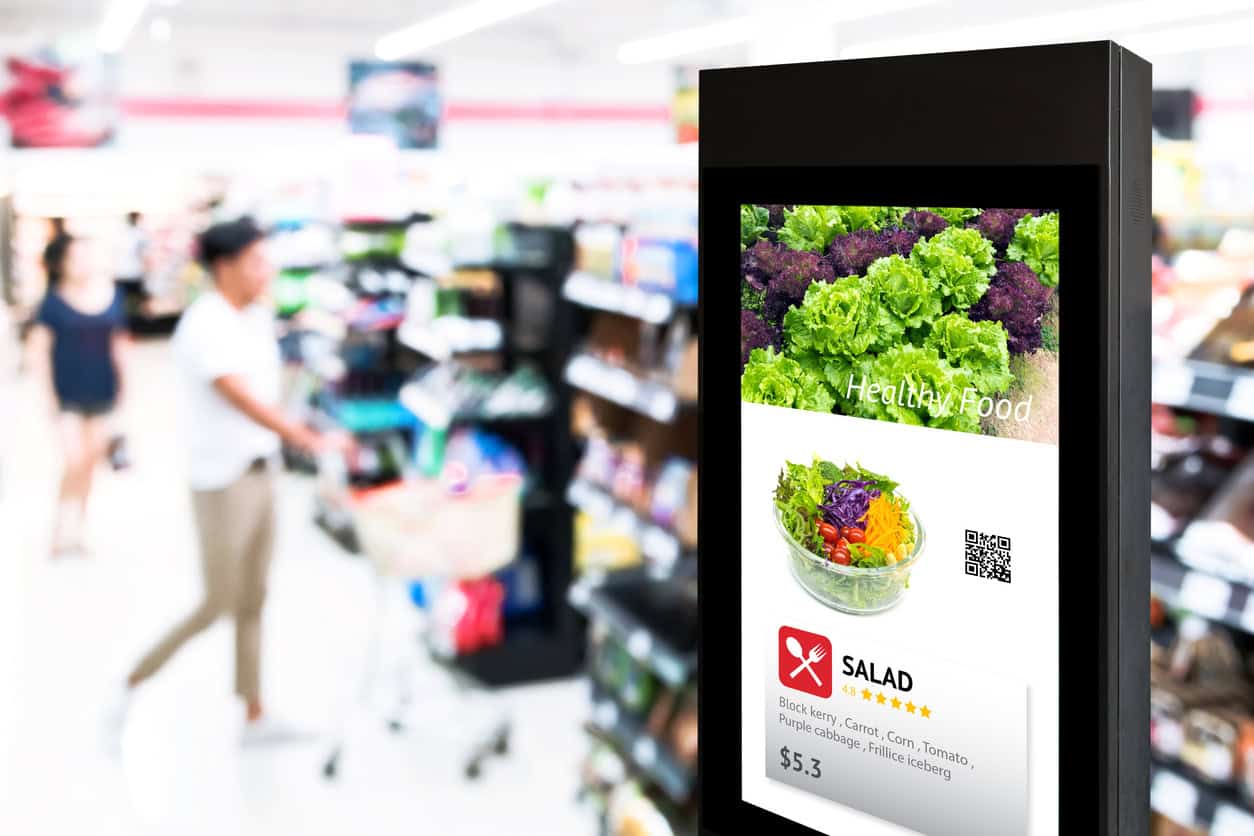
iStock.com/JIRAROJ PRADITCHAROENKUL
Do All Retailers Need In-Store Media Networks to Remain Viable?
In the bustling landscape of retail technology, one trend stands out: the burgeoning realm of in-store media networks. While not a new concept, its current surge in attention mirrors the fervor surrounding artificial intelligence.
As the retail landscape evolves, industry experts foresee a significant move of retail media into physical stores. Nick Larkins, the co-founder of in-store media company Qsic, highlighted the growing importance of proximity to the point of purchase, driving innovation in in-store tech.
“That’s why it feels like the entire industry is laser-focused on innovating and advancing the tech related to in-store touchpoints right now,” Larkins explained. “People on all sides of the business know it’s becoming paramount to engage consumers at this critical point in the path to purchase, whether that’s through video, audio or a mix of channels. Even non-endemic brands are seeing this value.”
With the deployment of interactive screens and personalized mobile notifications, retailers are enhancing the shopping experience, making each visit feel unique and special. This shift toward personalized engagement offers a compelling alternative to the impersonal nature of online shopping.
Looking ahead, Artem Lavrinovich, chief data and product officer of Cooler Screens, emphasized the integration of AI and data analytics as the future of retail media. “This integration will continue to develop, enabling more dynamic and context-sensitive advertising that resonates more effectively with consumers,” Lavrinovich said.
At recent exhibitions like the Retail Technology Show 2024, the spotlight fell on the accessibility of retail media solutions. Of particular intrigue were the cost-effective options that most retailers could implement, notably digital shelf edge advertising. One company reported that its clients’ sales increased by 30% to 80% in the U.S. through the adoption of simple digital shelf edge displays.
What sets these solutions apart is their adaptability. The ability to swap surrounding branding elements allows stores to tailor promotions dynamically, fostering customer engagement. QR codes augment this interaction, linking shoppers to supplementary information, tips, or recipes.
Additionally, lift-and-learn specialist Xtag Retail showcased how digital shelf edge displays can integrate seamlessly with lift-and-learn installations. This synchronization ensures that when customers interact with a product, the surrounding screen content adjusts accordingly. Such synergy not only optimizes existing in-store infrastructure but also enhances the overall customer experience.
At IAB NewFronts, T-Mobile Advertising Solutions unveiled plans for a retail media network across its 11,000+ stores, adding 20,000 screens to reach 240 million consumers. Leveraging anonymized data, T-Mobile aims for precise targeting through its T Life app and in-store displays. Partnering with Plex, the streaming platform, promises personalized ad experiences. This expansion reflects T-Mobile’s commitment to tailored advertising in an era of heightened relevance.
Here are some of the other major retailers currently taking advantage of retail media:
- Albertsons: Albertsons Media Collective collaborates with commerce media platform Criteo to enhance in-store retail media offerings. Leveraging first-party data and shopper information, Albertsons aims for precise ad targeting.
- Best Buy: Best Buy has partnered with CNET to integrate the publication’s content across its platforms, offering advertisers shared ad spaces and access to a combined audience of 50 million monthly visitors.
- Home Depot: Home Depot has rebranded its ad operation as Orange Apron Media, offering ad space on its website and in-store displays. With plans to double its number of supplier advertisers, Home Depot aims to capitalize on its vast customer base.
- Instacart: Instacart collaborates with Google Shopping, enhancing audience signals for advertisers’ campaigns. Additionally, Instacart introduced AI-powered smart carts for personalized recommendations through advertisements.
- Lowe’s: Lowe’s has partnered with Google on a retail media solution, extending advertisers’ reach to third-party channels. Through self-service capabilities and privacy-centric data sharing, Lowe’s aims to enhance ad targeting.
- Macy’s: Macy’s Media Network, overseen by Michael Krans, collaborates with advertisers across Macy’s and Bloomingdale’s to drive discovery and brand awareness among customers.
- Saks: Saks launched Saks Media Network, offering luxury brands sponsored product ads and display banners to increase revenue. Leveraging its rich first-party customer data, Saks strengthens its relationship with brands.
- Walmart: Walmart Connect has introduced various updates this year, including greater display access, media partnerships, and self-service capabilities. With a focus on growth and improved ad targeting, Walmart aims to elevate its advertising business.
Surprisingly, even banks are venturing into the realm of retail media. JPMorgan Chase is one such example, and it is leveraging its vast consumer reach and first-party data to do so. Chase Media Solutions, JPMorgan Chase’s latest venture, aims to offer personalized ads to its 80 million customers, tapping into the lucrative world of targeted advertising.
This move follows a trend where various industries, including rideshare companies like Uber, hospitality chains like Marriott, and fintech startups like Klarna, have embraced retail media as a means of enhancing customer engagement.
Chase’s strategy is driven by the potential of its first-party data and the demand for targeted advertising channels in the wake of changes to user tracking policies by tech giants like Apple. Through partnerships with brands like Air Canada and Solo Stove, Chase has piloted its program, reporting increased sales and customer growth.
The rise of retail media signifies a broader trend in advertising, with companies like Walmart and Amazon capitalizing on their first-party data to build robust advertising platforms. As Google phases out third-party cookies, the demand for retail media networks is expected to surge.
Discussion Questions
What implications does the surge of in-store media networks hold for the future of retail, especially with the resurgence of in-store shopping experiences?
What novel advancements in retail media networks are poised to redefine the in-store shopping experience, particularly in terms of personalized engagement and dynamic advertising?
As retail giants like Walmart and Amazon leverage first-party data to bolster their advertising platforms, how might smaller players like Albertsons and Home Depot differentiate their retail media offerings to remain competitive?
